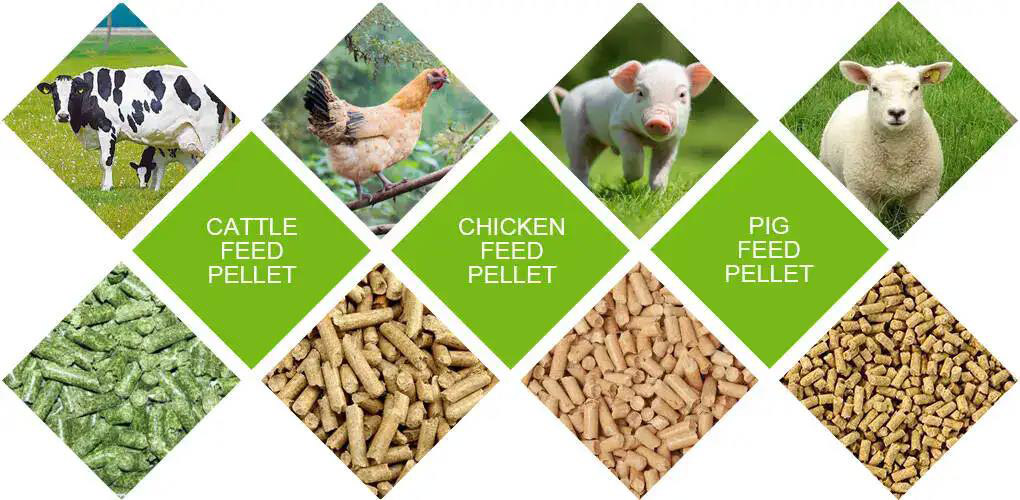This Poultry Feed Pellet Machine can be used to make feed pellets for all ages chicken. And it is a good choice for the farm owner and those who plans to step into the poultry feed making industry.
The material passing through the modulator enters the granulation chamber and is rapidly extruded through the ring die and the press roller to form cylindrical pellets. This is the basic principle of the feed pellet machine. The output of our small feed pellet machine is 1-2 tons per hour, which is more suitable for small farms or small animal feed mills so that the feed pellet produced can be used for own use or sold.
| Model | Capacity | Main Motor Power | Feeder Motor Power | Conditioner Power | Dia. of Ring Die | Pellet Size |
| SZLH250 | 1-2T/H | 22KW | 0.75kw | 1.5kw | 250mm | 2-12mm |
Making feed materials into compressed feed pellets can combine together all the nutritional ingredients that animal growth needs, and prevent picky animals, in order to maximize the economic benefits.
In addition, making it into feed pellets can also save the feed. For example, if you feed sheep with powder fodder, it is easily scattered, which can make sheep picky eaters. What’s more, the wind will also blow up the powdery feed, causing waste, and the utilization rate of feed is only 92%. But if made into pellets, the sheep are not able to choose what they’d like to eat, thus the utilization rate of feed can reach 99%, which makes a 7% Utilization Rate of Feed Increase. Other animals are the same.
By producing your own feed pellets with a feed pellet machine, you can save a sum of money on purchasing the made-up feed pellets, and you can adjust the feed pellets components in accordance with animal growth phases.
The feed Pellet machine is a key piece of equipment for the production of pellets, which are composed of multiple components. It is mainly composed of a drive system, feeding system, pelletizing system, etc.

This Poultry Feed Pellet Machine can be used to make feed pellets for all ages chicken. And it is a good choice for the farm owner and those who plans to step into the poultry feed making industry.
1. Stainless Stell Feeder 2. Gear reducer 3. Frequency Conversion Motor 4. SKF Bearing
5. Pelletizing Chamber 6. SIEMENS Motor 7.Conditioner Motor 8. Stainless Steel Conditioner
Typically, the production of sheep feed production line uses raw materials such as corn, soybeans, wheat, and other nutrients as the formula. Our feed pellet machine are specially used to produce feed for poultry, livestock, pigs, horses, cattle, sheep, chickens, ducks, goose and other animals.For different animals, with different growth cycles, (chicks, suckling pigs, calves, etc.), the feed pellet size required is different, but our feed production line only needs to replace ring molds with different apertures or use a pellet crumbler to reach the required size.

Advantages of our feed pellet production line?
1. The components of a complete feed pellet line can be TURN-KEY MADE, since Coban Machinery is professional in making animal feed processing plans, we can give you the MOST SUITABLE feed pellet production Business Plan.
2. All the machines are strictly developed and manufactured to guarantee PREMIUM QUALITY.
3. You can choose it for making many kinds of animal feeds, such as cattle, dairy cow, goat, sheep, horse, pig, chicken, broiler, duck, rabbit, fish, goose, etc.
4. We have experienced engineers for overseas installation and commissioning. We will also train your workers on how to operate the feed processing machines.
| Model | Capacity | Main Motor Power | Feeder Motor Power | Conditioner Power | Dia. of Ring Die | Pellet Size |
| SZLH250 | 1-2T/H | 22KW | 0.75kw | 1.5kw | 250mm | 2-12mm |
| SZLH320 | 3-4T/H | 37KW | 1.5kw | 2.2kw | 320mm | 2-12mm |
| SZLH350 | 5-7T/H | 55KW | 1.5kw | 3kw | 350mm | 2-12mm |
| SZLH420 | 8-12T/H | 110KW | 1.5kw | 7.5kw | 420mm | 2-12mm |
| SZLH508 | 10-18T/H | 160KW | 2.2kw | 11kw | 508mm | 2-12mm |
| SZLH558 | 15-25T/H | 180KW | 2.2kw | 11kw | 558mm | 2-12mm |
| SZLH678 | 20-30T/H | 220KW | 2.2kw | 11kw | 678mm | 2-12mm |
| SZLH768 | 25-42T/H | 280KW | 2.2kw | 11kw | 768mm | 2-12mm |
If you are interested in our medium feed pellet production line, please leave us a message with:
1. What animal feeds do you want to manufacture?
2. What capacity do you need?
3. What feed processing equipments do you need? (If you have no idea, just contact us for professional guidance!)
4. What raw materials do you have? (optional)